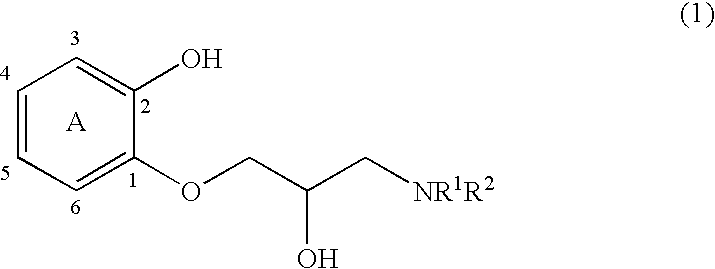1-Amido-3-(2-hydroxyphenoxy)-2-propanol derivatives and a process for preparing 2-amidomethyl-1,4-benzodioxane derivatives
a technology of 2-amidomethyl-1,4-benzodioxane and amido-3-(2-hydroxyphenoxy)-2-propane, which is applied in the preparation of carbonyl compounds, heterocyclic compound active ingredients, biocide, etc., can solve the problems of high cost of m-chloroperbenzoic acid, low yield, and high cost of oxidation agents
- Summary
- Abstract
- Description
- Claims
- Application Information
AI Technical Summary
Problems solved by technology
Method used
Image
Examples
example 1
(R)-1-(4-chloro-2-hydroxyphenoxy)-3-phthalimido-2-propanol
(Method A)
[0052] To a reaction vessel were added phthalimide 4.00 g (27.2 mmol), (R)-epichlorohydrin 4.52 g (49.0 mmol), benzyl trimethylammonium chloride 126 mg (0.68 mmol) and isopropanol 25 mL, and the mixture was stirred at 40° C. for 24 hours. To this mixture were dropped a mixture of potassium tert-butoxide 3.66 g (32.6 mmol) and isopropanol 15mL and the mixture was stirred at 20° C. for 3 hours. After evaporation of the solvent, the condensed residue was dissolved in ethyl acetate and washed with water. The organic layer was taken and recrystallized to give (R)-glycidylphthalimide 4.90 g (Yield 89%, chemical purity 96%) as a white crystal.
[0053]1HNMR (CDCl3, 270 MHz) δ2.70 (dd, 1H), 2.81 (dd, 1H), 3.21-3.28 (m, 1H), 3.81 (dd, 1H), 3.97 (dd, 1H), 7.27-7.91 (m, 4H)
[0054]13CNMR (CDCl3, 68 MHz) δ39.8, 46.3, 49.2, 123.4, 131.9, 134.1, 167.9
[0055] To a reaction vessel were added (R)-glycidylphthalimide 4.06 g (20.0 mmo...
example 2
(Method A)
[0064] To a reaction vessel were added (R)-glycidylphthalimide 5.80 g (28.6 mmol), 4-chloro-2-methoxyphenol 3.17 g (20.0 mmol), potassium carbonate 2.76 g (20 mmol) and DMF 60 mL, and the mixture was stirred at 80° C. for 46 hours. After evaporation of the solvent, to the condensed residue was added 1,2-dichloroethane and the mixture was washed with an aqueous 3% NaOH solution, an aqueous 1% HCl solution and an aqueous 5% NaCl solution successively. The organic layer was taken, and the solvent was evaporated to give (R)-1-(4-chloro-2-methoxyphenoxy)-3-phthalimido-2-propanol 4.20 g (yield 59%, chemical purity 90%) as a pale yellow solid.
example 3
(Method B)
[0065] To a reaction vessel were added 4-chloro-2-methoxyphenol 20.0 g (126 mmol), (S)-epichlorohydrin 23.3 g (252 mmol), benzyl trimethylammonium chloride 0.585 g (3.15 mmol), toluene 40 mL and water 40 mL. To this mixture was dropped an aqueous 24% NaOH solution 31.5 g (189 mmol) in an ice bath, and the mixture was stirred at room temperature for 36 hours. The water layer was removed and the organic layer was washed with an aqueous 5% HCl solution and a 5% NaCl solution successively. The organic layer was taken and the solvent was evaporated to give crude (R)-glycidyl 4-chloro-2-methoxyphenyl ether 22.1 g (yield 87%, chemical purity 93%) as a white solid.
[0066]1HNMR (CDCl3, 270 MHz) δ2.73 (dd, 1H), 2.90 (dd, 1H), 3.34-3.40 (m, 1H), 3.86 (s, 3H), 3.98 (dd, 1H), 4.24 (dd, 1H), 6.82-6.89 (m, 3H)
[0067]13CNMR (CDCl3, 68 MHz) δ44.6, 50.0, 56.0, 70.4, 112.3, 114.8, 120.1, 126.4, 146.5, 150.0
[0068] To a reaction vessel were added phthalimido 442 mg (3.00 mmol), crude (R)-gl...
PUM
 Login to View More
Login to View More Abstract
Description
Claims
Application Information
 Login to View More
Login to View More - R&D
- Intellectual Property
- Life Sciences
- Materials
- Tech Scout
- Unparalleled Data Quality
- Higher Quality Content
- 60% Fewer Hallucinations
Browse by: Latest US Patents, China's latest patents, Technical Efficacy Thesaurus, Application Domain, Technology Topic, Popular Technical Reports.
© 2025 PatSnap. All rights reserved.Legal|Privacy policy|Modern Slavery Act Transparency Statement|Sitemap|About US| Contact US: help@patsnap.com



